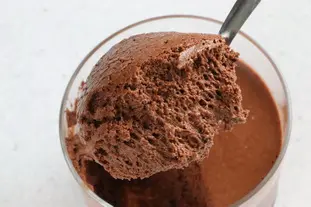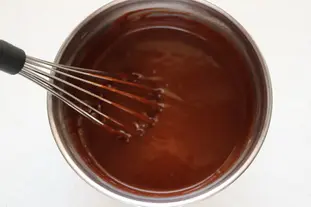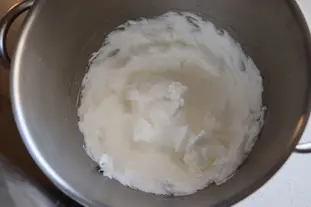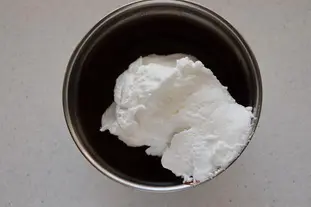This site uses only a few technical cookies necessary for its operation. By continuing to browse, you accept their use.
To find out more...
To find out more...
The 3 secrets of successful mousses

When you make a traditional mousse, that is to say without using a siphon, whatever the recipe, it's always the same principle: on one side you have a dense mixture, very tasty, and on the other side egg whites beaten until stiff.
All the difficulty of the success of a mousse, it will be to mix the two preparations which are of a very different density, without breaking everything, to obtain the famous mousse, subtle balance between lightness and taste.
All the difficulty of the success of a mousse, it will be to mix the two preparations which are of a very different density, without breaking everything, to obtain the famous mousse, subtle balance between lightness and taste.
9,883 4.6/5 (18 reviews)
Keywords for this post:MousseChocolateFruitTrickMeringueLast modified on: April 3rd 2021
The 3 secrets of successful mousses
For a chocolate mousse for example, the classic of classics, on one side you have chocolate melted in cream and added yolks, and on the other the whites beaten to snow.
The whites are gently incorporated into the chocolate mixture, which is mainly air, no secret, this is THE most delicate part of the recipe, let's see some tips to get it right.
According to your recipe, you will put more or less things in it, and sugar or not, I remain a fan of simple things: dark chocolate melted in cream in a bain-marie, smoothed with a whisk, egg yolks are added, smoothed again with a whisk and that's it.
Associated tip: add the egg yolks only when the chocolate mixture is smooth with a whisk, and not too hot, just lukewarm, also with a whisk, then smooth carefully again.
Related tips: It's not about making meringue, but you'll get much nicer whites if you "tighten" them by adding 20g of caster sugar (for 3 whites) halfway through. Their texture will be smoother, more creamy, and they will be easier to fold into the chocolate.
Intuitively, you would perhaps pour the chocolate over the whites and mix? This would be a mistake, you would risk "breaking" the whites.
It's a bit long and tricky, but that's where all the work is done. Stop when all the whites are well incorporated, there are no more "bundles of whites" not incorporated, be patient, in the end it is long to finish this incorporation ...
Divide into individual moulds and put in the fridge for at least 3 hours.
The above example is based on a chocolate mousse, but you can make all kinds of mousse on the same principle (whites + mixture) with instead of chocolate a (custard) cream with the fruits of your choice, or even a fruit coulis, but in this case you have to put a little gelatine in it while it is hot otherwise your mousse will not take.
A mousse is always a light and pleasant dessert, which finishes a meal in beauty, especially if it was a little rich.
In summary: The 3 secrets of a successful mousse are :
1) Adding the yolks with a whisk in a not too hot preparation
2) Whip the whites until they are stiff with a little powdered sugar
3) Incorporation in 2 steps, first we relax the mixture with a little whites with a whisk, and only then we incorporate gently with a maryse.
The whites are gently incorporated into the chocolate mixture, which is mainly air, no secret, this is THE most delicate part of the recipe, let's see some tips to get it right.
The chocolate mixture

According to your recipe, you will put more or less things in it, and sugar or not, I remain a fan of simple things: dark chocolate melted in cream in a bain-marie, smoothed with a whisk, egg yolks are added, smoothed again with a whisk and that's it.
Associated tip: add the egg yolks only when the chocolate mixture is smooth with a whisk, and not too hot, just lukewarm, also with a whisk, then smooth carefully again.
Whipped egg whites

Related tips: It's not about making meringue, but you'll get much nicer whites if you "tighten" them by adding 20g of caster sugar (for 3 whites) halfway through. Their texture will be smoother, more creamy, and they will be easier to fold into the chocolate.
Mixing the 2As
I said, this is the difficulty, because you want to mix something very light, airy, with a very thick cream, and above all you want to keep the light side of the whites, to find it in the chocolate and form the mousse. So you can't go at it like a brute with a spoon, everything would fall back, it wouldn't be a mousse.Intuitively, you would perhaps pour the chocolate over the whites and mix? This would be a mistake, you would risk "breaking" the whites.
How do you do it?
You have to proceed in 2 steps:

It's a bit long and tricky, but that's where all the work is done. Stop when all the whites are well incorporated, there are no more "bundles of whites" not incorporated, be patient, in the end it is long to finish this incorporation ...
Divide into individual moulds and put in the fridge for at least 3 hours.
The above example is based on a chocolate mousse, but you can make all kinds of mousse on the same principle (whites + mixture) with instead of chocolate a (custard) cream with the fruits of your choice, or even a fruit coulis, but in this case you have to put a little gelatine in it while it is hot otherwise your mousse will not take.
A mousse is always a light and pleasant dessert, which finishes a meal in beauty, especially if it was a little rich.
In summary: The 3 secrets of a successful mousse are :
1) Adding the yolks with a whisk in a not too hot preparation
2) Whip the whites until they are stiff with a little powdered sugar
3) Incorporation in 2 steps, first we relax the mixture with a little whites with a whisk, and only then we incorporate gently with a maryse.
Lasts posts
Butter vs. grease
We often read in a recipe where a pastry is put into a mould that, just before pouring, the mould should be buttered or greased. But what's the difference between these 2 terms?December 1st 20251,4965
Getting out of the fridge early
Very often when you're cooking, you need to take food or preparations out of the fridge, to use them in the recipe in progress. There's nothing tricky about this: you just take them out of the fridge and use them, usually immediately, in the recipe. But is this really a good method?November 24th 20251,2875
Who's making the croissants?
When you look at a bakery from the outside, you naturally think that in the bakery, the bakers make the bread, and in the laboratory, the pastry chefs make the cakes. It's very often like that, with each of these professions having quite different ways of working, but sometimes there's also one...November 23th 20251,179
Oven height
When we put a dish or cake in the oven, we naturally tend to put it on the middle shelf, and that's what we usually do. But in some cases, this position and height can be a little tricky, so let's find out why.October 8th 20253,3475
The importance of sieving
In recipes that use a fine powder (flour, powdered sugar, etc.), you'll often see the advice to sift before using it. To sift is to pass the powder in question through a sieve (a very fine strainer) before incorporating it into your recipe. It's often advice, but is it really useful?September 3rd 20257,9533
Other pages you may also like
Should I believe my oven?
Can you really trust your oven? This is an important question as we are always tempted to take the temperature indicated as gospel truth and, unfortunately, this is rarely very precise. .July 4th 201133 K4.6
The color of the bread crumb
When you go to buy bread, at your baker's, at the time of the choice, if you hesitate of course, you will undoubtedly be very sensitive to the color of the crust, and you will be right. The color of the crust, from golden, to sometimes very dark, deep brown almost black, depending on the maturity...April 30th 202221 K4.6
Butter doesn't make you fat, unless you eat too much of it.
Whenever I'm discussing cooking and recipes, there is one idea which comes up frequently, like this: "Oh no! But that's got butter in it" (I should add, for the sake of accuracy, that this is something I hear more frequently from women, who are almost all concerned with keeping their figure). ...March 26th 201245 K4.5
The mock CAP baker's certificate exam
The next instalment in my life as an apprentice baker at the French INBP professional school. I’m now halfway through training and it’s still as exciting as ever, and exhausting – but maybe I’m just getting old, or both… Anyway, a few days ago we had to go through the mock CAP exam. A sort...May 1st 201821 K4.4
The return of the "Norman hole"
You maybe know the "trou normand", this old gastronomic custom typically French which consists in taking a (small) glass of calvados, generally between the last course and the dessert? It's something that seems a bit anachronistic nowadays, having a glass of an alcohol of more than 60° in the...December 18th 202115 K4.8
Post a comment or question
Follow this page
If you are interested in this page, you can "follow" it, by entering your email address here. You will then receive a notification immediately each time the page is modified or a new comment is added. Please note that you will need to confirm this following.
Note: We'll never share your e-mail address with anyone else.
Alternatively: you can subscribe to the mailing list of cooling-ez.com , you will receive a e-mail for each new recipe published on the site.









